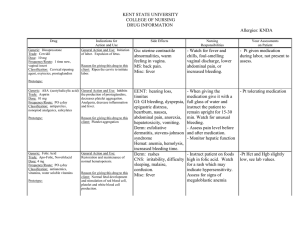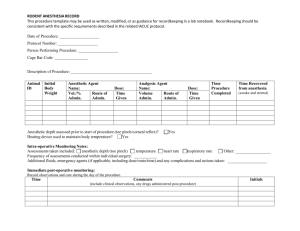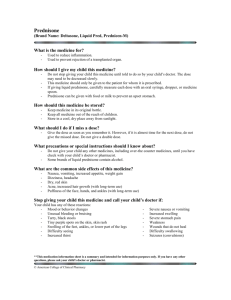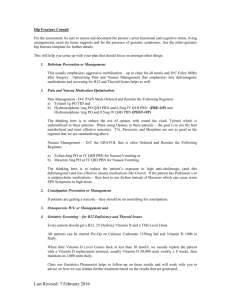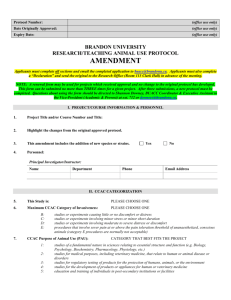Medications for LD paper
advertisement
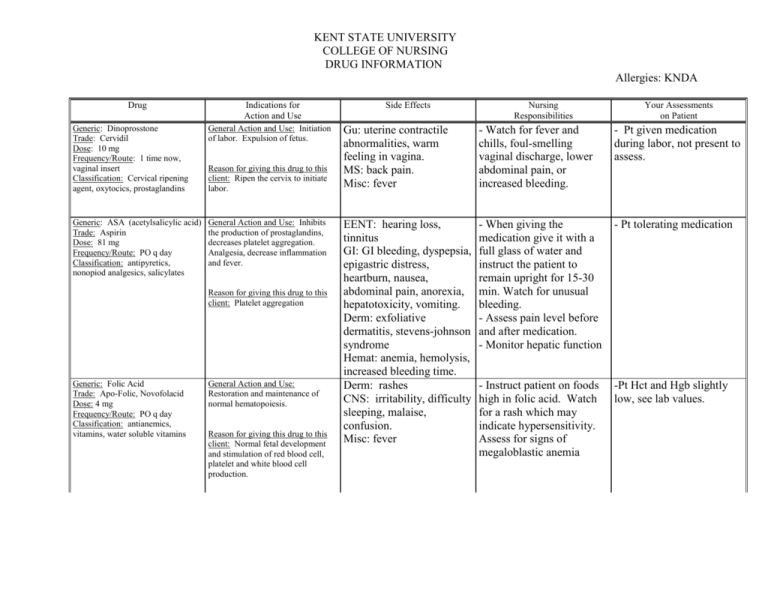
KENT STATE UNIVERSITY COLLEGE OF NURSING DRUG INFORMATION Allergies: KNDA Drug Indications for Action and Use Generic: Dinoprosstone Trade: Cervidil Dose: 10 mg Frequency/Route: 1 time now, vaginal insert Classification: Cervical ripening agent, oxytocics, prostaglandins General Action and Use: Initiation of labor. Expulsion of fetus. Generic: ASA (acetylsalicylic acid) Trade: Aspirin Dose: 81 mg Frequency/Route: PO q day Classification: antipyretics, nonopiod analgesics, salicylates General Action and Use: Inhibits the production of prostaglandins, decreases platelet aggregation. Analgesia, decrease inflammation and fever. Reason for giving this drug to this client: Ripen the cervix to initiate labor. Reason for giving this drug to this client: Platelet aggregation Generic: Folic Acid Trade: Apo-Folic, Novofolacid Dose: 4 mg Frequency/Route: PO q day Classification: antianemics, vitamins, water soluble vitamins General Action and Use: Restoration and maintenance of normal hematopoiesis. Reason for giving this drug to this client: Normal fetal development and stimulation of red blood cell, platelet and white blood cell production. Side Effects Nursing Responsibilities Your Assessments on Patient Gu: uterine contractile abnormalities, warm feeling in vagina. MS: back pain. Misc: fever - Watch for fever and chills, foul-smelling vaginal discharge, lower abdominal pain, or increased bleeding. - Pt given medication during labor, not present to assess. EENT: hearing loss, tinnitus GI: GI bleeding, dyspepsia, epigastric distress, heartburn, nausea, abdominal pain, anorexia, hepatotoxicity, vomiting. Derm: exfoliative dermatitis, stevens-johnson syndrome Hemat: anemia, hemolysis, increased bleeding time. Derm: rashes CNS: irritability, difficulty sleeping, malaise, confusion. Misc: fever - When giving the medication give it with a full glass of water and instruct the patient to remain upright for 15-30 min. Watch for unusual bleeding. - Assess pain level before and after medication. - Monitor hepatic function - Pt tolerating medication - Instruct patient on foods high in folic acid. Watch for a rash which may indicate hypersensitivity. Assess for signs of megaloblastic anemia -Pt Hct and Hgb slightly low, see lab values. Generic: OxycodoneAcetaminophen Trade: Percocet Dose: 5-325 mg tab Frequency/Route: PO PRN q 4 hrs Classification: Opioid analgesics, opioid agonists, opioid agonists nonopioid analgesic combination. General Action and Use: Binds to opiate receptors in the CNS. Decreases pain. Generic: Zolpoden Tartrate Trade: Ambien Dose: 10 mg Frequency/Route: PO PRN at bedtime Classification: sedative/ hypnotic General Action and Use: Produces CNS depression by binding to GABA receptors. Has no analgesic properties. Reason for giving this drug to this client: For moderate to sever pain after vaginal exam. Max 4000 mg acetaminophen per day. Reason for giving this drug to this client: For sleep, fall risk warning. Generic: Promethazine HCL Trade: Phenergan Dose: 25 mg Frequency/Route: PO q 4 hrs PRN Classification: antiemetics, antihistamines, sedative/ hypnotics, phenothiazines. General Action and Use: Has inhibitory effect on the chemoreceptor trigger zone in the medulla, resulting in antiemetic properties. Diminish nausea and vomiting. Reason for giving this drug to this client: Help prevent nausea and vomiting. CNS: confusion, sedation, dizziness, floating feeling, headache EENT: blurred vision, diplopia, miosis Resp: respiratory depression CV: orthostatic hypotension GI: constipation, dry mouth, n/v GU: urinary retention Derm: flushing, sweating Misc: physical dependence CNS: amnesia, daytime drowsiness, dizziness, “drugged” feeling. GI: diarrhea, nausea, vomiting. Misc: hypersensitivity reactions, physical dependence, tolerance. CNS: neuroleptic malignant syndrome, confusion, disorientation, sedation, dizziness, fatigue. EENT: blurred vision, diplopia, tinnitus. CV: bradycardia, hypertension, hypotension, tachycardia. GI: constipation, druginduced hepatitis, dry mouth. Derm: photosensitivity, rashes. - Assess type location and - Pt tolerating medication intensity of pain before and after giving the medication. - Assess blood pressure, pulse, and respirations periodically during administration. Assess level of sedation. - Assess for dependance -Assess mental status, sleep - Pt tolerating medication. patterns, and potential for abuse prior to administration. -Assess patient for pain. Medicate as needed. - Monitor blood pressure, pulse, and respiratory rate frequently in patients receiving IV doses. - Assess for allergy symptoms. - May increase glucose. - Pt tolerated medication well, decrease nausea and vomiting. Generic: Acetaminophen Trade: Tylenol Dose: 650 mg Frequency/Route: PO q 3 hrs PRN Classification: antipyretics, nonopioid analgesic General Action and Use: Inhibits the synthesis of prostaglandins. Analgesic, antipyresis. Generic: Ibuprofen Trade: Advil Dose: 600 mg Frequency/Route: PO q 6 hrs PRN Classification: nonopioid analgesic, antipyretics, anti-inflammatory, nonsteroidal. General Action and Use: Inhibits prostaglandin synthesis, decreases pain, reduces fever. Generic: Dulcolax Trade: Bisacodyl Dose: 1-2 Frequency/Route: RS PRN Classification: Laxaitive General Action and Use: Evacuation of the colon, stimulates peristalsis. Reason for giving this drug to this client: Mild Pain Reason for giving this drug to this client: Cramping Reason for giving this drug to this client: Constipation Generic: Simethicone Trade: Mylicon Dose: 80 mg Frequency/Route: PO q 6 hrs PRN Classification: Antiflatulent General Action and Use: Passage of gas through the GI tract by belching or passing flatus Reason for giving this drug to this client: Gas Pain GI: hepatic failure, hepatotoxicity (overdose) GU: renal failure Hemat: neutropenia, pancytopenia, leucopenia. Derm: rash, urticaria. - Assess overall health - Monitor hepatic, status before hematological and renal administration. function. - Assess type and location of pain before and after administration. - Assess for fever. CNS: headache, dizziness, - Assess pain for type, drowsiness. location, and intensity. EENT: amblyopia, blurred - Monitor temperature. vision, tinnitus. - Monitor BUN, CV: arrhythmias, edema. Creatinine, CBC, and liver GI: GI bleeding, hepatitis, function tests. May cause constipation, nausea, prolonged bleeding time. vomiting, abdominal discomfort. GU: cystisis, hematuria, renal failure. Derm: exfoliative dermatitis, stevensjohnson syndrome, rashes. Hemat: blood dyscrasias, prolonged bleeding time. GI: abdominal cramps, - Assess patient for nausea, diarrhea, rectal abdominal distention, burning. presence of bowel sounds, F and E: hypokalemia and usual patterns of bowel MS: muscle weakness functions. None Significant - Assess patient for abdominal pain, distention, and bowel sounds. Generic: Magnesium Salts Trade: MOM Dose: 10 ml Frequency/Route: 1st post-op day PRN Classification: Mineral and electrolyte replacements/ supplements, laxatives, salines. General Action and Use: Evacuation of the colon. Reason for giving this drug to this client: Constipation GI: diarrhea Derm: flushing, sweating - Assess patient for abdominal distention, presence of bowel sounds. - Assess heart burn and indigestion as well as location, duration, character of pain. Deglin, J.H., & Vallerand, A.H. (2005). Davis’s drug guide for nurses. Philadelphia, PA: Lippincot, Williams, & Wilkens.
